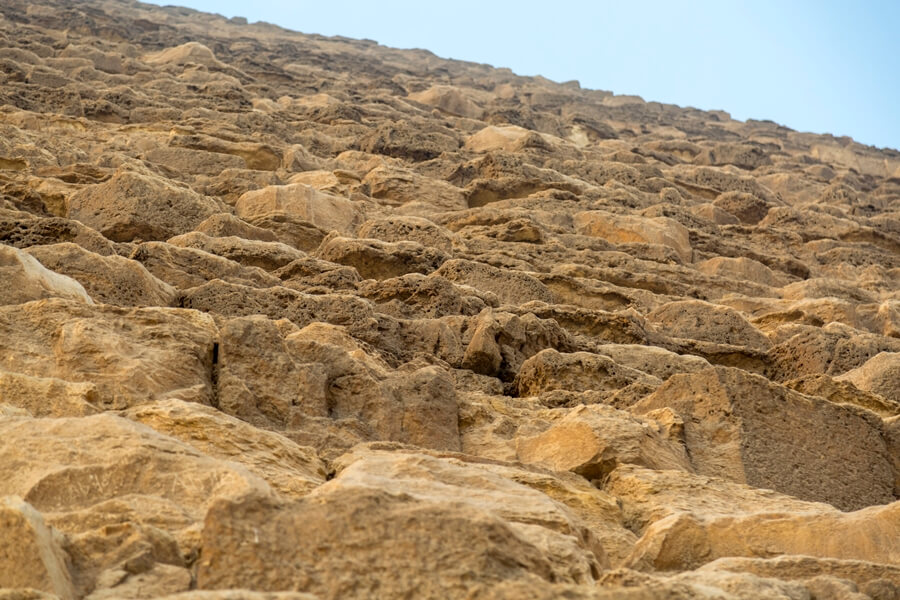Stay updated!
This is a question that’s been asked time and time again and continues to be asked today. The technique of constructing the pyramids is invariably the subject of many heated discussions among Egyptologists (we don’t shy away from discussing that during the luxury small group tours in Egypt that we organize here at Inside Egypt). None of the records from the times of the Old Kingdom reveal the secrets from the builders of that time. One of the first sources of information about this topic dates back to antiquity, but also much later in Greece. Should we believe it? That’s something you can learn as you take part in our Egypt pyramid tours.
The Cheops/Khufu Pyramid, also known as the Great Pyramid, consists of huge blocks of stone, with a total weight of over 6 million tons. The amazing structure was originally 147 meters high. It was created almost 4,600 years ago and was the greatest work of man throughout the millennia. It was not until the 14th century that a taller Gothic cathedral was erected in England.

Twenty-One Centuries after Construction
The man who was named the first historian in history - the Greek, Herodotus, an author - has already written about the construction of the great pyramid. This doesn’t mean, however, that he lived in a time when the construction of the pyramids was taking place. He was born a slight twenty-one centuries after the builders of Khufu's pyramid!
Herodotus – written in his famous "The Histories" he claimed that he personally traveled to Egypt. However, opinions on if he wrote the truth are divided among historians. If the journey took place, it would have been between 470-440 B.C.E.

One Hundred Thousand People Did the Job
The narrative stated that he had seen the pyramids and that the translator who accompanied him on the trip had told him how they were built. Words from an anonymous "tourist guide" from thousands of years ago still ignite researchers' imaginations today.
Here’s what Herodotus wrote:
“Until King Rampsynite, Egypt was in full legal order (...) and Egypt enjoyed great prosperity, and after him King Cheops led him to extreme poverty. He closed all the temples (...) then he ordered everyone to work for him. ”
“Well, for one of them, they were instructed to drag stones from the quarries in the Arabian Mountains as far as the Nile. As the stones were shipped across the river, he ordered others to collect them and drag them to the so-called Libyan Mountains. And they worked in succession for three months for one hundred thousand people.”
“The period of ten years has passed for the tormented people on the construction of the road, along which they dragged the stones, and which they built as a work not much smaller, in my opinion, than the pyramid itself (...).”
“So it took ten years to build this road and the underground tombs on that hill on which the pyramids stand; these chambers he had built as tombs on the island, with the channel of the Nile there. And twenty years had elapsed in the construction of the pyramid itself.”

Was It the Truth or Just a Fairy Tale?
One fact has definitely been rendered as the truth. The pharaoh, Cheops mentioned by Herodotus was real, although his name had been Hellenized. In fact, he was called Khufu.
Long Island University Egyptologist, Bob Brier said the numbers cited by Herodotus also sounded reasonable. In his opinion, the construction of the pyramid could actually be a simultaneous movement by 90 to 100,000 people, working in a three-month cycle, correlated with the floods of the Nile. They were not slaves at all.
The stories of the extraordinary oppression that took place under Khufu/Cheops still influences popular perceptions of Egypt, although scientists say they have very little to do with the facts. Rather, the pyramids were built by farmers, ordinary inhabitants of the country, assigned to complete this task at a time when the floods of the Nile made it impossible to work in the field.

Built in Intervals
Most discussions and considerations are related to information on construction techniques. Herodotus wrote in his "The Histories":
“This pyramid was built like this: at intervals that some call stairs, others call steps. After taking the first interval, they lifted the rest of the stones up in machines they made of short pieces of wood, lifting the boulders off the ground to the first row of intervals.”
“Whenever a stone got out of that row, it was put on top of another machine that stood in the first row of steps, and from this it was pulled out by that other machine to the second row. Machine, because it was unique and easy to carry, in each row whenever they took a stone out of it (I prefer to mention both ways, as they tell about them).”
“The uppermost part of the pyramid ahead was completed, then they made the adjoining parts, and finally finished the mundane and the lowest parts.”

Never Been Replicated
Did the described machines really exist? It's hard to believe that accurate information about them could last for millennia. One thing seems certain, however, such mechanisms could be created both in the times of the Old Kingdom and in the times of Herodotus.
We know this because in recent years attempts have been made to reconstruct them based on a historiographic description and they seem to be working. Although, no one has built the entire pyramid using them just yet...
Do you want to know more about the wonderful history of Egypt? Check out our luxury Egypt tours for more details!